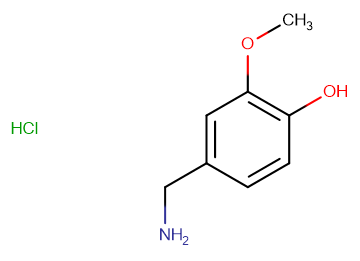
4-Hydroxy-3-methoxybenzylamine hydrochloride
CAS No. 7149-10-2
4-Hydroxy-3-methoxybenzylamine hydrochloride( —— )
Catalog No. M15732 CAS No. 7149-10-2
Vanillylamine is an alkaloid that is an intermediate in the biosynthesis of capsaicin. Vanillylamine is produced from vanillin by the enzyme vanillin aminotransferase.
Purity : >98% (HPLC)
 COA
COA
 Datasheet
Datasheet
 HNMR
HNMR
 HPLC
HPLC
 MSDS
MSDS
 Handing Instructions
Handing Instructions
| Size | Price / USD | Stock | Quantity |
| 5MG | 37 | In Stock |


|
| 10MG | 45 | In Stock |


|
| 25MG | 61 | In Stock |


|
| 50MG | 98 | In Stock |


|
| 100MG | 129 | In Stock |


|
| 200MG | 181 | In Stock |


|
| 500MG | Get Quote | In Stock |


|
| 1G | Get Quote | In Stock |


|
Biological Information
-
Product Name4-Hydroxy-3-methoxybenzylamine hydrochloride
-
NoteResearch use only, not for human use.
-
Brief DescriptionVanillylamine is an alkaloid that is an intermediate in the biosynthesis of capsaicin. Vanillylamine is produced from vanillin by the enzyme vanillin aminotransferase.
-
DescriptionVanillylamine is an alkaloid that is an intermediate in the biosynthesis of capsaicin. Vanillylamine is produced from vanillin by the enzyme vanillin aminotransferase.
-
In Vitro——
-
In Vivo——
-
Synonyms——
-
PathwayOthers
-
TargetOther Targets
-
RecptorOthers
-
Research Area——
-
Indication——
Chemical Information
-
CAS Number7149-10-2
-
Formula Weight189.64
-
Molecular FormulaC8H12ClNO2
-
Purity>98% (HPLC)
-
SolubilitySoluble in Ethanol
-
SMILESCl.COC1=C(O)C=CC(CN)=C1
-
Chemical Name——
Shipping & Storage Information
-
Storage(-20℃)
-
ShippingWith Ice Pack
-
Stability≥ 2 years
Reference
1. Flagan SF, Leadbetter JR. Environ Microbiol. 2006 Mar;8(3):560-5.
molnova catalog



related products
-
Parishin G
Parishin G.
-
2-Iodoacetamide
2-Iodoacetamide is an alkylating agent, and is a commonly used agent for alkylation of cysteine during sample preparation for proteomics.
-
Band 3 Protein (824-...
Band 3 Protein (824-829) (human)



 Cart
Cart
 sales@molnova.com
sales@molnova.com


